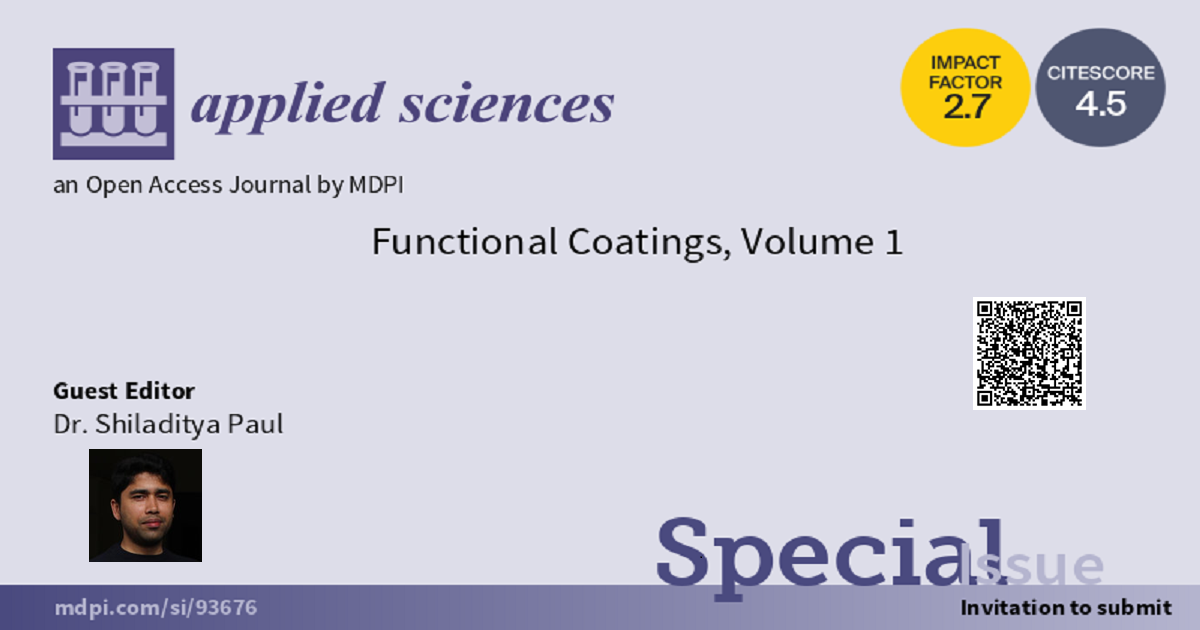Functional Coatings, Volume 1
A special issue of Applied Sciences (ISSN 2076-3417). This special issue belongs to the section "Surface Sciences and Technology".
Deadline for manuscript submissions: closed (30 September 2023) | Viewed by 13565

Special Issue Editor
Interests: new materials development; thermal spray coatings; corrosion; electrochemistry; batteries; CCUS; CO2 conversion; high entropy alloy coatings
Special Issues, Collections and Topics in MDPI journals
Special Issue Information
Dear Colleagues,
Coatings often allow process equipment to be purposeful in environments well beyond the operational limit of uncoated components. In addition to protection, some coatings also provide additional functions, such as sensors. Durability, ease of application, repairability, reliability, and long-term performance of such coatings are vital to their application. The overall cost-effectiveness of these functional coatings is key to their industrial uptake. Therefore, this Special Issue of Applied Sciences, “Functional Coatings” is devoted to research and review articles on the metallic, non-metallic, and composite coatings used in various environments.
In particular, the topics of interest include but are not limited to:
- Coatings for temperature-sensing applications;
- Photoactive coatings;
- Self-healing coatings;
- Corrosion-, wear-, and cavitation-resistant coatings;
- Coatings for aeroengine turbines, such as thermal barrier coatings;
- Coatings for thermal management;
- High-entropy alloy coatings.
Dr. Shiladitya Paul
Guest Editor
Manuscript Submission Information
Manuscripts should be submitted online at www.mdpi.com by registering and logging in to this website. Once you are registered, click here to go to the submission form. Manuscripts can be submitted until the deadline. All submissions that pass pre-check are peer-reviewed. Accepted papers will be published continuously in the journal (as soon as accepted) and will be listed together on the special issue website. Research articles, review articles as well as short communications are invited. For planned papers, a title and short abstract (about 100 words) can be sent to the Editorial Office for announcement on this website.
Submitted manuscripts should not have been published previously, nor be under consideration for publication elsewhere (except conference proceedings papers). All manuscripts are thoroughly refereed through a single-blind peer-review process. A guide for authors and other relevant information for submission of manuscripts is available on the Instructions for Authors page. Applied Sciences is an international peer-reviewed open access semimonthly journal published by MDPI.
Please visit the Instructions for Authors page before submitting a manuscript. The Article Processing Charge (APC) for publication in this open access journal is 2400 CHF (Swiss Francs). Submitted papers should be well formatted and use good English. Authors may use MDPI's English editing service prior to publication or during author revisions.
Keywords
- corrosion
- coatings
- electrochemistry
- thermal spraying
Benefits of Publishing in a Special Issue
- Ease of navigation: Grouping papers by topic helps scholars navigate broad scope journals more efficiently.
- Greater discoverability: Special Issues support the reach and impact of scientific research. Articles in Special Issues are more discoverable and cited more frequently.
- Expansion of research network: Special Issues facilitate connections among authors, fostering scientific collaborations.
- External promotion: Articles in Special Issues are often promoted through the journal's social media, increasing their visibility.
- e-Book format: Special Issues with more than 10 articles can be published as dedicated e-books, ensuring wide and rapid dissemination.
Further information on MDPI's Special Issue polices can be found here.





